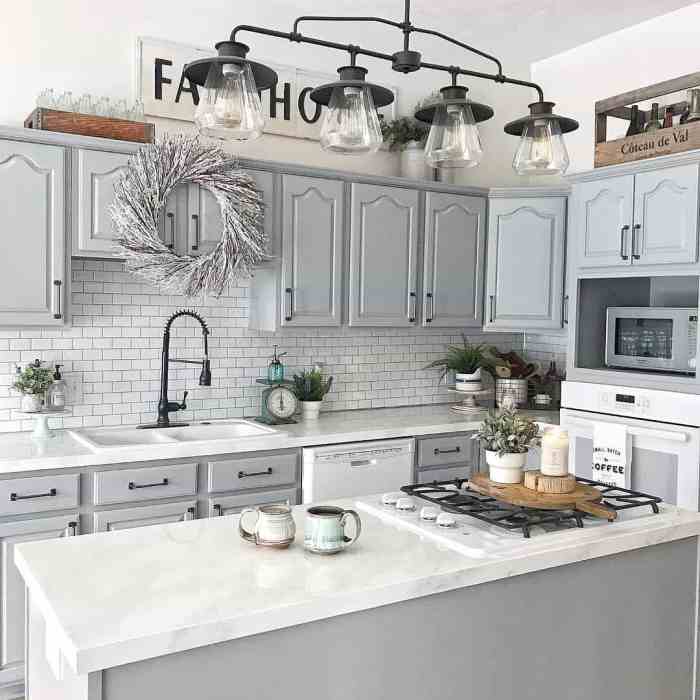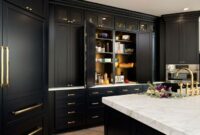Farmhouse cabinets offer a timeless appeal, blending rustic charm with modern functionality. Their enduring popularity stems from a versatile design aesthetic that complements various kitchen styles, from traditional to contemporary farmhouse settings. This guide delves into the diverse world of farmhouse cabinets, exploring their history, construction, design variations, and integration into a cohesive kitchen design. We’ll cover everything from choosing the right wood and finish to selecting appropriate hardware and installation techniques, ensuring you have the knowledge to create your dream farmhouse kitchen.
From the classic Shaker style with its clean lines to the more ornate French Country designs, the options are vast. Understanding the nuances of each style, the materials used, and the available finishes will be key to making informed decisions. We will also explore different cabinet construction methods and how to properly install them, empowering you to tackle this project with confidence, whether you’re a seasoned DIYer or a first-time home renovator.
Farmhouse Cabinet Styles
Farmhouse cabinets evoke a sense of rustic charm and enduring practicality, blending seamlessly with both traditional and modern interiors. Their enduring appeal lies in their versatility and ability to adapt to diverse design aesthetics, from the cozy warmth of a country kitchen to the sleek sophistication of a contemporary space. This section explores three distinct farmhouse cabinet styles, highlighting their unique features and dimensions.
Three Distinct Farmhouse Cabinet Styles
Let’s delve into three unique interpretations of the farmhouse cabinet, each offering a distinct aesthetic and functional approach. These designs all utilize a standard 36-inch base cabinet width for comparison.
- Rustic Farmhouse: This style embraces natural imperfections. Imagine a cabinet crafted from reclaimed wood, showing variations in grain and color. The doors might feature a simple raised panel design, perhaps with slightly uneven edges for a more authentic look. Hardware could be simple black or brushed nickel knobs or pulls. Dimensions: 36″W x 34.5″H x 24″D (including standard countertop allowance).
- Modern Farmhouse: This style blends rustic elements with clean lines and contemporary functionality. The cabinet might be constructed from painted wood, possibly a crisp white or soft gray, with sleek, minimalist hardware. The doors could feature a flat-panel design or a subtly recessed panel. A subtle, textured finish adds depth without sacrificing a clean aesthetic. Dimensions: 36″W x 34.5″H x 24″D (including standard countertop allowance).
- Transitional Farmhouse: This style bridges the gap between traditional and contemporary. The cabinet could be made from a medium-toned wood like oak or maple, with a slightly more ornate door design than the modern farmhouse style, perhaps incorporating slightly arched tops or decorative molding. The hardware might be a mix of metals, such as brushed nickel and antique brass.
Farmhouse cabinets offer a rustic charm, perfect for kitchens and informal spaces. However, if you need a sleek and organized storage solution for a professional setting, consider the clean lines and functionality of Modern Office Cabinets. While vastly different in style, both types prioritize efficient storage; the choice depends entirely on the desired aesthetic and the room’s purpose.
Ultimately, the right cabinet style enhances the overall feel of any space.
Dimensions: 36″W x 34.5″H x 24″D (including standard countertop allowance).
Shaker, Mission, and French Country Farmhouse Cabinet Styles: A Comparison
These three styles represent distinct branches of the farmhouse aesthetic, each with its own historical roots and design principles.
- Shaker: Known for its simple, unadorned design, Shaker cabinets emphasize functionality and clean lines. The defining feature is the flat-panel door with a simple frame. Materials typically include solid wood, often painted in neutral colors like white or cream. The hardware is typically understated and functional.
- Mission: Mission cabinets are characterized by their strong, horizontal lines and substantial construction. They often feature heavy, square-shaped frames and simple, flat panels. Dark-stained wood, such as oak or mahogany, is commonly used. Hardware is usually simple and functional, often in dark metal.
- French Country: French Country cabinets evoke a sense of rustic elegance. They often feature ornate detailing, such as carved moldings, decorative hardware, and curved lines. Materials include lighter-colored woods, often with a distressed or antiqued finish. The hardware is typically more decorative than in Shaker or Mission styles.
Historical Influences and Evolution of Farmhouse Cabinet Design
Farmhouse cabinet design reflects the evolution of rural life and craftsmanship. Early farmhouse cabinets were primarily functional, constructed from readily available materials and built to withstand daily use. The simplicity of Shaker cabinets, for instance, reflects the Shaker community’s emphasis on practicality and minimalism. As technology and design influences evolved, so did farmhouse cabinets. The introduction of new materials and manufacturing techniques allowed for greater ornamentation and variety in style, leading to the emergence of styles like French Country, which incorporated more elaborate detailing and decorative elements.
Farmhouse cabinets offer a rustic charm, but if you’re looking to elevate your kitchen’s aesthetic with superior craftsmanship and materials, explore the options available through High-End Cabinetry Solutions. They can help you achieve that perfect blend of farmhouse style and high-end quality, ensuring your cabinets are both beautiful and built to last. Ultimately, the choice depends on your desired level of luxury and investment for your farmhouse kitchen.
The mid-20th century saw a decline in popularity, but a renewed interest in handcrafted items and rustic aesthetics in recent decades has led to a resurgence of farmhouse style, with designers blending traditional elements with modern sensibilities to create unique and versatile pieces. For example, the incorporation of metal accents or the use of painted finishes on traditionally wood-only styles represents a modern twist on a classic design.
Materials and Finishes for Farmhouse Cabinets
Choosing the right materials and finishes is crucial for achieving the authentic look and feel of farmhouse-style cabinets. The wood you select will significantly impact the overall durability, cost, and aesthetic of your project, while the finish determines the cabinet’s final appearance and how well it withstands daily wear and tear. Let’s explore some popular options.
Wood Type Comparison for Farmhouse Cabinets
The selection of wood significantly impacts the final look and feel of your farmhouse cabinets. Consider durability, cost, and aesthetic appeal when making your choice.
| Wood Type | Durability | Cost | Aesthetic Appeal |
|---|---|---|---|
| Oak | High; strong and resistant to dents and scratches | Medium to High | Classic, warm tones; can be stained or painted; prominent grain |
| Pine | Medium; softer wood, more susceptible to dents; knots add character | Low to Medium | Rustic, casual; readily accepts paint and stain; visible knots and grain |
| Maple | High; hard and dense; resists scratches well | Medium to High | Clean, smooth; light-colored; versatile for various stains and paints; fine grain |
Applying a Distressed White Paint Finish
Achieving a convincingly distressed white finish requires a multi-step process. This technique adds character and enhances the farmhouse aesthetic.
- Preparation: Thoroughly clean and sand the cabinet doors and frames to ensure a smooth surface for optimal paint adhesion. Fill any imperfections with wood filler and sand smooth.
- Primer: Apply a high-quality primer designed for adhesion to wood. This will create a uniform base for the paint and prevent bleed-through.
- Base Coat: Apply two coats of your chosen white paint, allowing each coat to dry completely before applying the next. Use a high-quality paint designed for cabinets for durability.
- Distressing: Once the paint is dry, use sandpaper (120-220 grit) to gently sand away some of the paint in areas that would naturally wear down, such as edges, corners, and raised details. Focus on highlighting the wood grain in some areas for a more authentic look.
- Waxing (Optional): Apply a clear wax to protect the distressed areas and give the finish a subtle sheen. Buff the wax to a smooth finish.
- Topcoat (Optional): For added protection, apply a clear topcoat specifically designed for painted surfaces. This will help to prevent chipping and scratches.
Stain Finish Designs for Farmhouse Cabinets
Three stain options offer distinct farmhouse aesthetics.
- Warm Honey Oak: A medium-toned stain with amber undertones. This creates a rich, inviting look that complements many farmhouse styles. The final appearance is a warm, inviting golden brown, highlighting the natural grain of the wood.
- Weathered Gray: A gray stain with subtle hints of brown and blue undertones. This finish evokes a rustic, aged look, suggesting years of weathering and use. The result is a sophisticated yet rustic gray, perfect for a more modern farmhouse aesthetic.
- Classic Black: A deep, rich black stain. This creates a dramatic contrast against lighter walls and countertops, lending a sophisticated and modern twist to the farmhouse style. The final appearance is a deep, matte black that enhances the wood grain’s texture.
Hardware and Accessories for Farmhouse Cabinets
Choosing the right hardware and accessories can truly make or break the farmhouse aesthetic. The details matter, and selecting the perfect pieces will elevate your cabinets from functional to stunning. Consider the overall style of your kitchen and the level of detail you want to achieve when making your selections.
Suitable Hardware Options for Farmhouse Cabinets
The style of hardware significantly impacts the overall feel of your farmhouse cabinets. A wide variety of options exist, each contributing a unique character.
- Knobs: These offer a classic and simple look, perfect for a more traditional farmhouse style. Materials range from ceramic and porcelain for a more rustic feel to brushed nickel or oil-rubbed bronze for a slightly more modern take. Finishes can include matte black, antique brass, or even painted options to match your cabinet color.
- Pulls: Pulls provide a more substantial grip and are well-suited for larger drawers and doors. Styles vary greatly, from simple cup pulls to elongated bar pulls. Materials include metal (brass, iron, zinc alloy), wood, and even leather. Finishes are as diverse as those for knobs.
- Cup Pulls: These offer a charming and slightly more decorative option, sitting flush against the cabinet face. Cup pulls typically come in metal, often with a slightly aged or distressed finish to enhance the farmhouse look. They’re ideal for a more refined or detailed farmhouse style.
Decorative Elements for Farmhouse Cabinet Design
Beyond hardware, various decorative elements can add significant visual appeal and reinforce the farmhouse aesthetic.
- Corbels: These decorative brackets are often used to support shelves or cabinet overhangs. They add a touch of architectural detail and visual interest, particularly when made of wood with a distressed finish or painted a contrasting color. The intricacy of the carving can range from simple to highly ornate, depending on the desired level of detail.
- Beadboard: Beadboard paneling is a classic farmhouse element that can be used on cabinet doors or as an accent within the cabinet design. Its simple, repeating pattern creates a clean and timeless look. Painting it a bright white or a soft, muted color enhances its visual impact.
- Raised Panels: Raised panel doors add a touch of elegance and sophistication to farmhouse cabinets. The raised panels create visual depth and texture, complementing the overall rustic charm. The style of the raised panel can vary; some are simple and understated, while others are more ornate and detailed.
Custom Hardware Design: The “Willow Creek” Pull
This design focuses on a simple yet elegant pull, perfect for a mid-century modern farmhouse style.
Description: The “Willow Creek” pull is a simple, slightly curved bar pull crafted from solid brass. Its understated elegance complements both traditional and contemporary farmhouse styles. The gentle curve adds a touch of softness, preventing it from appearing overly stark or industrial.
Farmhouse cabinets offer a charming, rustic aesthetic, perfect for kitchens and bathrooms alike. If you’re looking for truly unique pieces to perfectly match your vision, consider exploring bespoke cabinetry options; check out the amazing work at Bespoke Cabinetry Services for inspiration. They can help you create the farmhouse cabinets of your dreams, down to the smallest detail.
Materials: Solid brass, with options for different finishes (e.g., brushed nickel, oil-rubbed bronze, antique brass).
Dimensions: Length: 6 inches, Height: 1 inch, Thickness: 0.5 inches. The gentle curve would have a radius of approximately 1 inch.
Finish: A protective clear coat would be applied to prevent tarnishing. Custom powder coating would allow for a wide range of colors and finishes.
Mounting: Two concealed screws would be used for secure attachment to the cabinet door.
Cabinet Construction and Installation: Farmhouse Cabinets
Building and installing farmhouse cabinets is a rewarding DIY project that can significantly enhance your kitchen’s aesthetic appeal and functionality. This section details the process, from initial wood cutting to the final hardware installation, along with a comparison of different construction methods.
Face Frame vs. Frameless Cabinet Construction
Face frame cabinets, the traditional style, feature a frame surrounding the cabinet box. This frame provides structural rigidity and allows for easier door and drawer alignment. Frameless cabinets, on the other hand, lack this outer frame; the doors and drawers are mounted directly to the cabinet box. Face frame cabinets tend to be more durable and easier to repair, while frameless cabinets offer a more modern, sleek look and maximize interior space.
Farmhouse cabinets offer a charming, rustic aesthetic, perfect for kitchens and bathrooms. But if you need more organized storage solutions beyond the kitchen, consider expanding your design with custom cabinetry in other areas of your home. Check out the options for Custom Closet Cabinets to complement your farmhouse style, ensuring a cohesive and functional look throughout.
Then, bring those same farmhouse elements – maybe distressed wood or simple hardware – into your closet design for a unified feel.
The choice depends largely on personal preference and the overall design aesthetic. Face frame construction is generally considered more forgiving for less experienced builders due to its inherent stability. Frameless requires precise measurements and joinery for optimal results.
Building a Basic Farmhouse Cabinet
Constructing a simple farmhouse cabinet involves several key steps. First, cut the wood components according to your design plan. This includes the sides, top, bottom, and back panels, as well as any internal shelves or dividers. Ensure all cuts are precise and square to guarantee a strong, well-fitting cabinet. Next, assemble the cabinet box using appropriate joinery such as dowels, pocket screws, or dadoes.
Apply wood glue and clamps to secure the joints and allow sufficient drying time. Once the box is assembled, attach the back panel, usually a thin plywood sheet. Finally, install the face frame (if using face frame construction) and then attach the doors and drawers, ensuring proper alignment and functionality.
Installing Farmhouse Cabinets
Proper cabinet installation involves careful preparation and precise measurements. Begin by preparing the wall, ensuring it’s plumb and level. This may involve shimming uneven areas. Next, install wall cleats or bracing to provide a solid mounting surface for the cabinets. Position the base cabinets according to your design plan, using a level to ensure they are perfectly aligned.
Secure the cabinets to the wall cleats using appropriate screws. Upper cabinets are typically mounted to the wall using similar techniques, paying close attention to alignment with the base cabinets. After all cabinets are securely fastened, install the countertops and backsplash. Finally, install the cabinet doors, drawers, and hardware. Accurate measurements and precise alignment are crucial for a professional-looking and functional result.
Using a laser level can significantly improve accuracy during the installation process.
Step-by-Step Cabinet Installation Guide
- Wall Preparation: Assess the wall for levelness and plumbness. Use shims to correct any irregularities.
- Cleat Installation: Install wall cleats or bracing at the desired height, ensuring they are level and firmly secured to the wall studs.
- Cabinet Placement: Carefully position the base cabinets, using a level to ensure they are perfectly aligned both horizontally and vertically. Adjust as needed using shims.
- Cabinet Securing: Secure the cabinets to the wall cleats using appropriate screws. Use multiple screws per cabinet for optimal stability.
- Upper Cabinet Installation: Repeat steps 3 and 4 for upper cabinets, ensuring proper alignment with the base cabinets.
- Countertop and Backsplash Installation: Install countertops and backsplash according to manufacturer’s instructions.
- Door and Drawer Installation: Install cabinet doors and drawers, ensuring proper alignment and functionality.
- Hardware Installation: Install cabinet knobs, pulls, and hinges.
Farmhouse Cabinet Integration in Kitchen Design

Source: soulandlane.com
Farmhouse cabinets, with their timeless appeal and versatile design, offer a unique opportunity to enhance any kitchen’s aesthetic and functionality. Their integration requires careful consideration of the overall kitchen style, desired functionality, and the interplay between cabinets, countertops, and backsplashes. Successful integration hinges on thoughtful planning and a cohesive design approach.
Farmhouse Cabinet Integration in Various Kitchen Styles
The adaptability of farmhouse cabinets allows for seamless integration into diverse kitchen styles. In traditional kitchens, shaker-style farmhouse cabinets in warm, neutral tones like creamy white or soft gray, paired with granite or marble countertops and a subtle backsplash, create a classic and elegant look. A modern farmhouse kitchen might feature sleek, minimalist farmhouse cabinets in a crisp white or light gray, complemented by butcher block countertops and a subway tile backsplash for a contemporary feel.
Rustic kitchens benefit from distressed wood farmhouse cabinets in darker shades, combined with reclaimed wood countertops and a stone backsplash, to evoke a cozy and inviting atmosphere. For example, a traditional kitchen might use a U-shaped layout, maximizing storage and counter space, while a modern farmhouse kitchen might opt for an L-shaped layout with an island for a more open and social feel.
Color schemes should reflect the overall style – warm earth tones for rustic, cool neutrals for modern farmhouse, and classic creams and whites for traditional.
Cabinet Size and Placement for Optimal Kitchen Functionality
Proper cabinet size and placement are crucial for efficient kitchen workflow. Consider the “work triangle” – the area connecting the sink, stove, and refrigerator – and ensure cabinets are positioned to support easy movement and access to frequently used items. Deep drawers are ideal for storing pots and pans, while upper cabinets should be easily accessible without requiring excessive reaching.
Farmhouse cabinets offer a charming, rustic appeal, perfect for creating a cozy kitchen atmosphere. If you’re looking for something truly unique, however, consider the possibilities of Custom Kitchen Cabinets to perfectly match your farmhouse style. You can achieve that classic farmhouse look with the added benefit of personalized design and superior quality, ensuring your cabinets are as durable as they are beautiful.
For instance, a galley kitchen with farmhouse cabinets might utilize tall pantry cabinets on one wall to maximize storage in a limited space. A large kitchen could incorporate an island with farmhouse cabinets for extra counter space and storage, creating a focal point. Careful measurement and planning are vital to ensure cabinets fit perfectly and don’t impede movement or obstruct appliances.
Visual Description of a Kitchen Design Featuring Farmhouse Cabinets
Imagine a kitchen bathed in soft, natural light. The focal point is a stunning island crafted from reclaimed wood, topped with a thick, honed Carrara marble countertop. The island features shaker-style farmhouse cabinets in a warm, creamy white, offering ample storage. These cabinets extend to the perimeter walls, maintaining consistency in style. A simple, yet elegant, white subway tile backsplash creates a clean backdrop, complementing the creamy white cabinets and the cool tones of the marble.
The overall aesthetic is one of rustic charm and modern functionality. The warm tones of the wood island and the cool tones of the marble countertop create a beautiful contrast, while the white subway tile provides a clean and timeless element. The ambiance is welcoming and inviting, a space where family and friends can gather and create lasting memories.
The natural light enhances the warmth of the wood and the brightness of the white, creating a harmonious and serene atmosphere.
Summary
Designing and installing farmhouse cabinets is a rewarding process that allows for significant creative expression. By understanding the various styles, materials, finishes, and construction techniques, you can create a kitchen that reflects your personal taste and enhances your home’s overall aesthetic. Remember to consider the overall kitchen design, including countertops, backsplash, and hardware, to achieve a harmonious and functional space.
Whether you opt for a rustic, modern farmhouse, or traditional look, your farmhouse cabinets will serve as a beautiful and enduring centerpiece of your home for years to come.
Question & Answer Hub
What are the typical dimensions of a farmhouse cabinet?
Standard base cabinets are typically 36 inches wide, but other sizes are available, ranging from smaller 12-inch units to larger 48-inch or even wider options.
How do I clean farmhouse cabinets?
Use a soft cloth and mild soap and water solution. Avoid abrasive cleaners that could damage the finish. For stubborn stains, try a paste of baking soda and water.
How long do farmhouse cabinets last?
With proper care and maintenance, well-constructed farmhouse cabinets can last for decades, even generations.
Are farmhouse cabinets suitable for bathrooms?
Yes, many farmhouse cabinet styles are suitable for bathrooms, especially those with moisture-resistant finishes.
Can I customize the size and configuration of my farmhouse cabinets?
Absolutely! Many manufacturers and custom cabinet makers offer a wide range of customization options to fit your specific needs and space.



